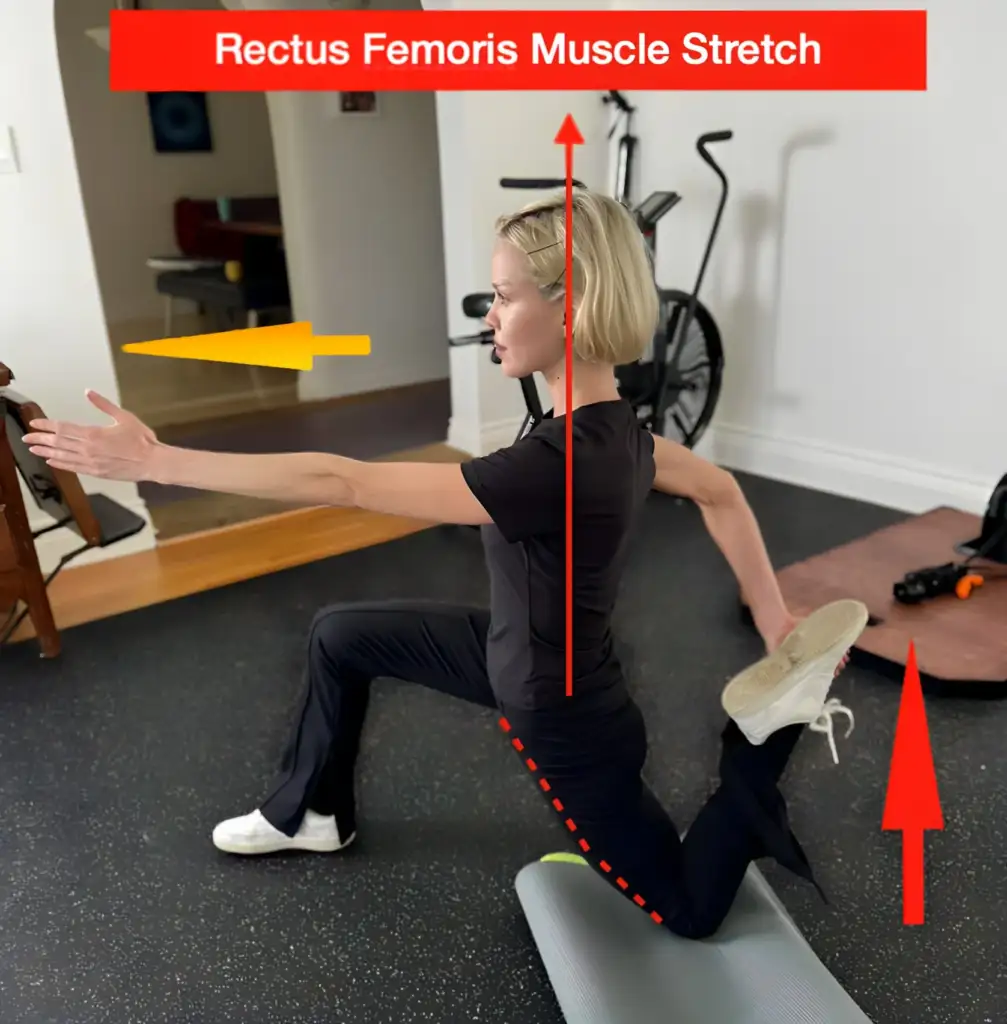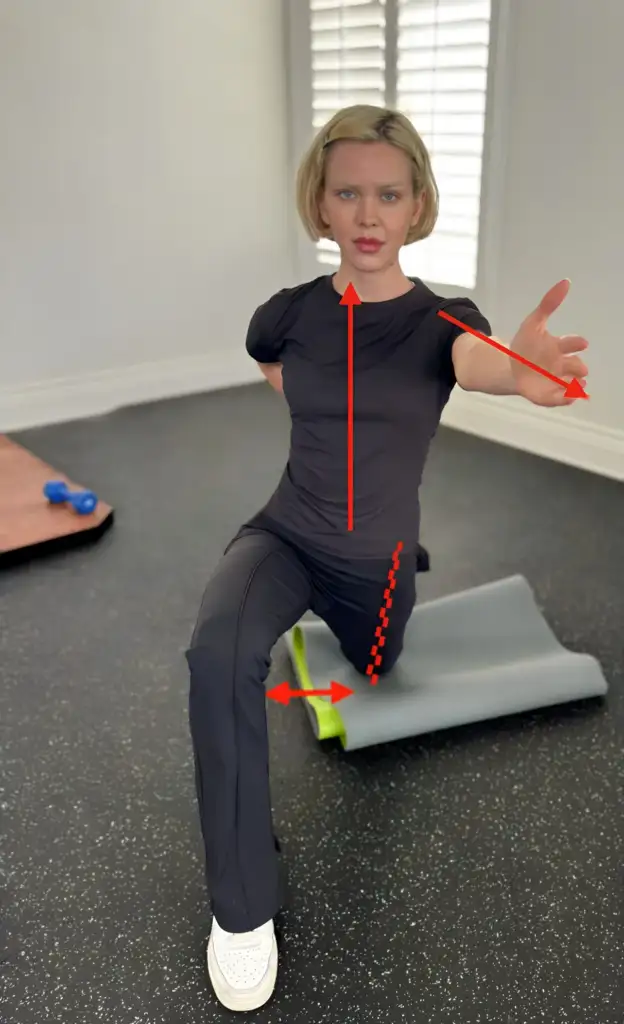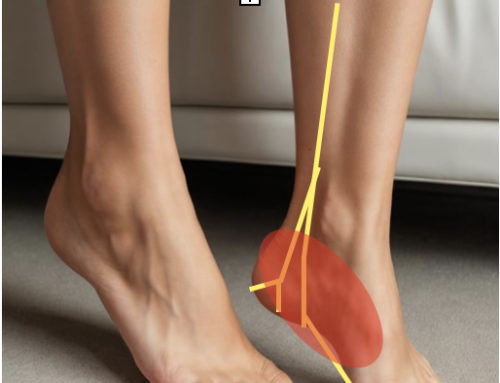How To Stretch The Rectus Femoris Muscle

Comprehending the Rectus Femoris Muscle
The rectus femoris is a quadriceps muscle at the front of the thigh. It is crucial in extending the knee and flexing the hip. Its functionality is indispensable in activities like walking, running, and leaping. However, continuous engagement in such activities may lead to tightness and injury susceptibility if the muscle is not adequately stretched and maintained.
Best Mobility Techniques To Increase Range of Motion
Beginners

- Starting Position: Start in a lunge position when the forward leg is slightly wider than the hips, and the foot is slightly further away from the body than the knee. The same-sided arm as the leg being stretched is reaching away from the body in a forward direction at the level of the shoulder joint.
- Grabbing the back knee by the top of the foot and then pulling the foot to the buttocks.
- Hold for 30 seconds and repeat 3-5 times a day.
Advanced
To increase the intensity of the stretch, flatten the back by tucking the pelvis and then pull the working leg into internal rotation by pulling the foot farther away from the body.
Benefits of Increase Rectus Femoris Muscle Flexibility
Regularly incorporating flexibility exercises targeting the quads into your workout routine offers numerous advantages:
- Enhanced Flexibility: these exercises for the muscles enhance flexibility, facilitating a broader range of motion in the hip and knee joints.
- Reduced Injury Risk: Extending or lengthening by elongation of the muscle addresses tightness and imbalances, aiding in the prevention of strains and overuse injuries, especially in activities involving running, jumping, or kicking.
- Improved Performance: Increased flexibility can enhance athletic performance, enabling more efficient movement patterns and more significant power generation.
- What increases performance also acts as sports injury prevention.
- Relief from Muscle Tension: Increasing the flexibility of the quadriceps muscle helps alleviate tension and discomfort in the front of the thigh, promoting relaxation and comfort during physical activities
Precautions and Tips for Stretching
- Warm-Up Adequately: Before exercising, ensure you sufficiently warm up your muscles. Engage in dynamic movements such as leg swings, high knees, or walking lunges to increase blood flow and prepare your muscles for work.
- Listen to Your Body: Listen to your body’s signals during stretching. Push to the point of tension, but avoid pushing into sharp pain or discomfort. Discomfort is normal, but pain could indicate overstretching or potential injury.
- Gradually Increase Intensity: Start with gentle lengthening maneuvers and progressively increase the intensity over time. Avoid sudden, jerky movements that could strain the muscle.
- Maintain Proper Alignment: Pay attention to your body alignment during stretches. Keep your spine neutral and avoid overarching your lower back, which can place excessive stress on the lumbar spine.
-
- Keeping the pelvis tucked is a vital part of this specific technique.
- Breathe Deeply and Relax: Practice deep breathing while stretching to promote relaxation and release muscle tension. Inhale deeply through your nose and exhale slowly through your mouth, allowing your body to sink deeper into each repetition with each exhale.
- Hold Stretches Consistently: Hold each for 20-30 seconds to allow the muscle fibers to elongate gradually. Avoid bouncing or pulsing movements, as they can cause micro-tears in the muscle fibers and increase the risk of injury.
- Incorporate Variety: Explore different stretching techniques and variations to target the muscle from various angles.
-
- The technique in this blog is the most specific elongation method for the muscle.
- Stay Hydrated: Adequate hydration is essential for maintaining muscle flexibility and preventing cramping during exercises. Drink water before and after to keep your muscles hydrated and supple.
- Avoid Overstretching: While it’s essential to stretch the muscles, avoid overstretching, especially if you’re new to stretching or have a history of injury. Respect your body’s limits and progress gradually to prevent strains or sprains.
-
- The first barrier of resistance is optimal.
- Seek Professional Guidance: If you’re unsure about proper stretching techniques or have specific concerns or injuries, consider consulting a certified fitness trainer, physical therapist, or healthcare professional for personalized guidance and recommendations.
Common Mistakes to Avoid (Quadriceps Muscles)
- Bouncing
- Avoid aggressive, forceful movements
- Don’t push through pain.
This stretch should be avoided if you are actively experiencing a labral tear in the hip or actively seeking physical therapy for any lower extremity condition.
Consult your healthcare provider prior to engaging in a new flexibility training program.
Conclusion
The rectus femoris is a quadriceps muscle that, when stiff, can cause a variety of injuries to the hip and knee. Increasing its strength and mobility can maintain hip and knee health and increase sports performance.
In any rehabilitation program for the hip, knee, and lower back, it’s important to also targeted techniques for the other hip flexors and hamstring muscles.
Reach out to Dr. Dean (sports doctor) in California by texting (best), calling 323-354-6077, or emailing at drjustindean@gmail.com
Our editorial practices include evidence-based practices, interventions, and recommendations.





